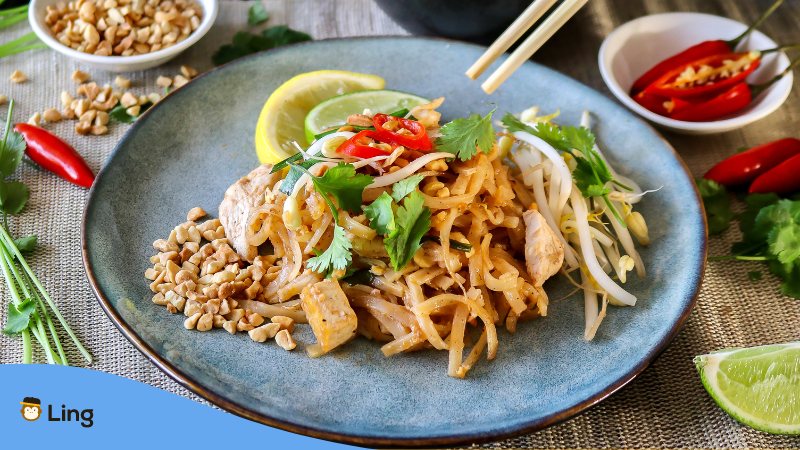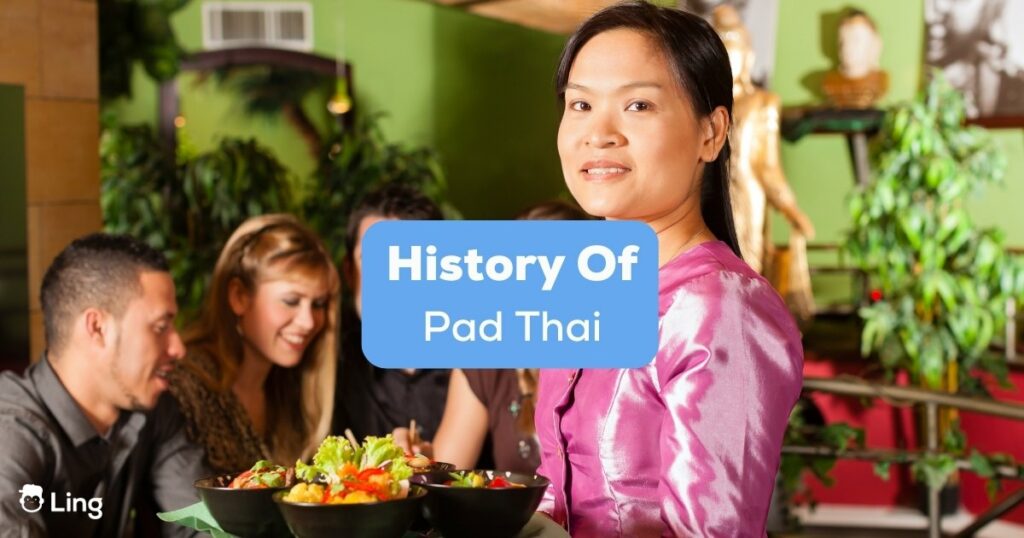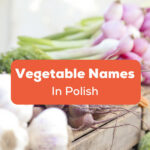ผัดไทย (pàt tai) or Pad Thai is not just a dish; it’s a symphony of flavors that will make your taste buds sing. If you’ve never had one, you’re missing out on one of the most popular and beloved Thai dishes ever.
But what’s the real history of Pad Thai? Where did this stir-fried rice noodles come from, and how did it become a national symbol of Thailand?
Well, my hungry friend, join me as we go back in time — from the Chinese origins of the noodle dishes to the Thai government’s promotion of a national dish competition.
But that’s not all; we’ll also uncover some forgotten and overlooked aspects of Pad Thai’s history that might surprise you while you practice some relevant Thai vocabulary! Let’s get to it.
1. Origins Of Pad Thai
Thai cuisine is globally known for its bold flavors and aromatic spices. But did you know that many of its dishes are a blend of culinary and cultural influences from China and Southeast Asia? This is especially true for the beloved noodle dish, Pad Thai.
Chinese Influence On Thai Cuisine
The influence of Chinese traders and immigrants on Thai cuisine is quite significant. Firstly, they introduced noodles and stir-frying techniques to Thai cuisine.
The Noodles
Noodles, which were already a staple food in China, were quickly introduced to Thailand by Chinese immigrants. Noodles were versatile and could be used in various dishes, from soups to stir-fries.
They were also easy to store and transport, making them a convenient food for street vendors. Thai cuisine soon adopted noodles, which became a significant ingredient in many Thai dishes, including Pad Thai.
The Stir-Frying Technique
Secondly, stir-frying, which involves quickly cooking ingredients over high heat in a wok, was also popular in China.
The Chinese immigrants adapted this technique to suit local ingredients and flavors in Thailand. Eventually, stir-frying became a standard cooking method in Thai cuisine as well.
The immigrants also introduced other cooking techniques and ingredients to Thai cuisine, including using soy sauce, tofu, and other vegetables.
The Creation Of Pad Thai
It has two names, phad thai and gway teow pad thai. The former is the Thai name for the dish, while the latter is a Chinese term for a similar stir-fried noodle dish.
Chinese immigrants who came to Thailand adapted the Chinese stir-fry technique to create Pad Thai using local ingredients such as tamarind and fish sauce.

Evolution Of Pad Thai
Pad Thai evolved from a Chinese-style stir-fried noodle dish to a distinctively Thai one. The Chinese version often featured thicker noodles and was typically made with soy sauce.
In contrast, the Thai version incorporated fish sauce, tamarind paste, and palm sugar to create a sweet, sour, and savory sauce.
The addition of ingredients such as dried shrimp, bean sprouts, and lime wedges also helped to create the unique flavor profile that we associate with Pad Thai today.
The National Dish Competition
In the 1930s, the Thai government launched a national dish competition to find a dish representing Thailand to the world.
Pad Thai was one of the dishes that entered the national competition, and it ultimately won, cementing its status as a beloved dish in Thai cuisine.
2. Development Of Pad Thai As Thailand’s National Dish
Pad Thai may have won the national dish competition in the 1930s. However, it wasn’t until the 1940s that Pad Thai truly became a symbol of Thai identity and nationalism.
This was during the tenure of Prime Minister Phibunsongkhram, who sought to modernize Thailand and promote a sense of Thai nationalism.
He recognized the power of food in shaping national identity and used Pad Thai as a way to promote Thai culture and cuisine.

3. Pad Thai As A Symbol Of Resistance
During World War II, Thailand was under Japanese occupation, and Phibunsongkhram used Pad Thai to symbolize resistance against colonial powers.
He encouraged the consumption of Pad Thai to promote Thai food and culture, and it became a popular dish among locals and foreign soldiers.
This helped to establish Pad Thai as a dish that was deeply rooted in Thai culture and identity.
4. Public Welfare Department’s Campaign For Pad Thai
In the post-war years, the history of Pad Thai continues. During this period, the Public Welfare Department launched a campaign to teach and sell Pad Thai across the country.
Street vendors were trained to make the dish using standardized recipes and ingredients. It became a popular and affordable street food.
Over time, Pad Thai became a staple in Thai restaurants worldwide and adapted to different regions and taste preferences.
5. Original Pad Thai Main Ingredients
Pad Thai is a beloved dish for its complex flavors and textures. This authentic Thai food has various ingredients, each adding a unique element to the final product.
Some of the key ingredients used in a Pad Thai recipe include:
- Rice Noodles: Pad Thai is made with thin, flat rice noodles that are soaked in water before cooking.
- Fish Sauce: This pungent, salty sauce is made from fermented fish and is a staple in Thai cuisine. It adds depth and complexity to the dish.
- Tamarind Paste: This tangy paste is made from the pulp of the tamarind fruit and gives Pad Thai its distinctive sour flavor.
- Palm Sugar: This sweetener is made from palm tree sap and balances out the sour and salty flavors of the dish.
- Bean Sprouts: These crunchy sprouts add texture and freshness to the dish.
- Lime Wedges: A squeeze of fresh lime juice adds brightness and acidity to the dish.
- Dried Shrimp: These tiny shrimp are used as a flavoring agent and add a salty umami flavor.
There are many variations and substitutions of Pad Thai ingredients based on regional and personal preferences. Some Pad Thai style may include tofu, chicken, or shrimp, while others may use different vegetables or spice levels. It’s all about finding what works best for you.

6. Pad Thai Beyond Thailand
Pad thai has gone beyond its status as a national dish in Thailand and has gained global popularity, becoming a beloved dish in many other countries.
As Thai cuisine continues to gain international recognition, it is no surprise that Pad Thai has made its way into the menus of Thai restaurants worldwide.
However, its popularity outside of Thailand has led to various interpretations and adaptations of the dish.
Some restaurants and chefs may add their unique twist to the recipe, incorporating local ingredients or altering traditional cooking methods to appeal to their customers.
This has led to debates and controversies over the authenticity and quality of Pad Thai served outside of Thailand.
While some argue that these adaptations may dilute the traditional flavor and essence of the dish, others say that it is simply a natural evolution of cuisine as it adapts to new cultures and tastes.
Despite these debates, one cannot deny the widespread love and appreciation for Pad Thai around the world.
From food stalls in bustling Asian markets to upscale restaurants in cosmopolitan cities, Pad Thai has become a staple dish for many who crave its delicious flavors and satisfying texture.
Useful Vocabulary About Pad Thai
If you love Pad Thai and are planning a trip to Thailand, you must learn Thai and some basic phrases to help you order in a local restaurant.
These phrases will help you communicate more effectively and enhance your Pad Thai experience.
Helpful Conversational Phrases
In addition to the vocabulary, learning some Thai conversational phrases related to the dish can be helpful. These phrases can help you navigate menus, order food, and communicate with locals about your preferences.
| English | Thai | Pronunciation |
| I would like to order Pad Thai please. | ผม/ดิฉันอยากสั่งผัดไทยค่ะ/ครับ | pǒm/dì-chǎn yàak sàng pàt tai kâ/khráp |
| How much is Pad Thai? | ผัดไทยกี่บาทคะ/ครับ? | pàt tai gìi bàat ká/khráp? |
| Is the Pad Thai here delicious? | ผัดไทยที่นี่อร่อยไหมคะ/ครับ? | pàt tai tîi nîi à-ròi mái ká/khráp? |
| Can I have Pad Thai without peanuts? | ผัดไทยไม่ใส่ถั่วลิสงหน่อยได้ไหมคะ/ครับ? | pàt tai mâi sài tùa lîsong nòi dâi mái ká/khráp? |
| Pad Thai with a little bit of spice/normal/spicy. | ผัดไทยเผ็ดน้อย/ปกติ/มาก | pàt tai pèt nói/bpòk dtì/mâak |
| Can I have the bill/check? Can I pay now? | ขอเช็คบิล/เก็บเงินได้ไหมคะ/ครับ? | kǎw chék bin/gèp ngern dâi mái ká/khráp? |
| Can I have some salted chili and fish sauce on the side please? | ขอพริกเกลือ/น้ำปลาเพิ่มหน่อยคะ/ครับ | kǎw prik glǔa/náam bplaa pêrm nòi ká/khráp |
| Delicious! | อร่อยจัง! | à-ròi jang! |
| Thank you. | ขอบคุณคะ/ครับ | kǎw bpun ká/khráp |
Learning the above Thai phrases can make your dining experience more enjoyable and authentic.
Whether you’re in Thailand or at a Thai restaurant abroad, these phrases can help you show your appreciation for their cuisine. So don’t hesitate to practice and use them next time you order Pad Thai!

Learn The History Of Pad Thai With Ling App
The history of Pad Thai is not just about the evolution of a dish but also a reflection of the rich cultural influences that have shaped Thai cuisine.
From Chinese immigrants to the government’s efforts to promote Thai identity through food, Pad Thai has become a symbol of the country’s history and resilience.
Today, as we savor this iconic dish’s sweet, sour, and savory flavors, we can appreciate the unique blend of ingredients and techniques that have come together to create a culinary masterpiece.
If you want to learn more about Thai culture and cuisine, try the Ling app! It has not only the Thai language but over 60 languages to learn.
With the Ling app, you can discover the world through language and food and enrich your understanding of different cultures.
Download from App Store or Google Play now!



































































